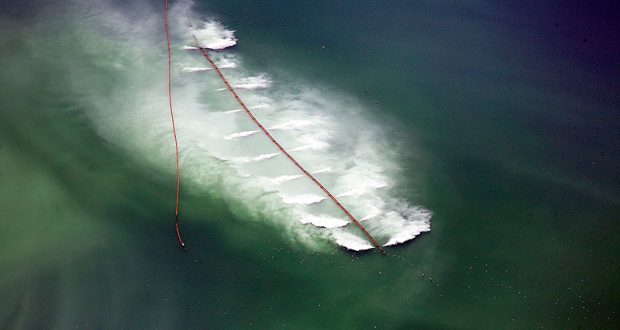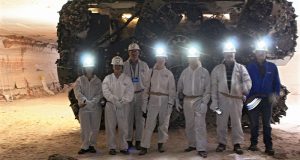Lignite can only be extracted from opencast mines if the ground water level is lowered to below the coal seam. This has a strong influence on the region’s water balance. Depending on the chemism from the overburden, the rising ground water after mining in the pit lake may become acidic due to pyrite weathering. Thus ground water remediation projects seek to balance out the ground water deficit and to neutralise the lakes in the former mines so that flora and fauna may be established. Lime is usually used in this process, e. g., using ships to introduce lime into the lake water with sprinkler systems. Large quantities of lime are needed to treat an entire water body, however, as there is only a low level of blending that takes place in the process. The GMB GmbH, Senftenberg/Germany, developed the Underwater Nozzle Pipelines method (UNP) as an alternative: lime mixed with lake water is pumped through the nozzles of floating pipes into the lake, where it uses the natural lake circulation to blend thoroughly, distributing the suspension evenly throughout the lake. The method has now been successfully demonstrated in a pilot project in Lake Scheibe, Lusatia.

Fig. 2. Injection of the lime suspension. // Bild 2. Injizieren der Kalksuspension. Photo/Foto: LMBV
The Federal Mining Act (BBergG) stipulates that operators carry out rehabilitation measures for the surfaces areas of former mines. This also applies to the lakes they produce. The lignite mining region of Lusatia alone has 36 pit lakes with an aggregate expanse of 146.8 million m2 and a water volume of 2,287 bn m3. Their pH values vary from 7.5 to an acidic 3.0, which in itself precludes the emergence of a functioning ecosystem. This prompted the GMB GmbH to develop the UNP method using submerged floating pipes equipped with nozzles within a project group in 2010. Other partners in the group were Fels-Werke GmbH, Institut für Wasserwirtschaft, Ökologie und Siedlungsbau IWSÖ GmbH, the Kemmer/Harbauer GmbH Group and Linde Gas. They used the laboratories of the Brandenburg University of Technology Cottbus-Senftenberg (BTU).
“GMB GmbH applied to carry out both a pilot and a demonstration project – initial neutralisation and CO2 buffering”, said Eckhard Scholz, Head of the Engineering Division at Lausitzer und Mitteldeutsche Bergbau-Verwaltungsgesellschaft mbH (LMBV). The LMBV is responsible for recultivation of the region’s lignite mining area. Among other measures, it uses pilot and demonstration projects to develop innovative technical solutions for water treatment, from their technical inception to a scale suitable for actual remediation measures. The projects were carried out in Lake Scheibe, Lusatia, which holds approximately 110 million m3 of water. It had an acid concentration before primary neutralisation of 381 million moles (Figure 1).
A fixed plant was built on the lake shore for the first stage of the project, initial neutralisation, between October 2011 and January 2012. Its purpose was to blend lake water with lime, on-site. Six pairs of nozzles were fitted at equal intervals of 20 m to a floating pipe located around 50 cm beneath the surface of the water during this time. Afterwards, a 4 % suspension consisting of 15,200 t of slaked lime and 440,000 m3 of lake water was pumped into the lake at a speed of around 7.6 m/s and a flow rate of 260 m3/h for six days per week over a period of 16 weeks (Figure 2).
The GSD method exploits the phases of lake circulation to ensure ideal blending with the lake water. The lime is introduced to the epilimnion layer. But the waters in the lake possess different densities, which ensure that the lime is distributed throughout the lake during the phases of full circulation in spring or autumn. Distribution of the lime suspension is therefore entirely natural and does not require any external energy source. In this manner the pH value was increased from 2.9 to seven. The neutral range is between approximately six and eight. Water circulation was used once more in a secondary treatment from May to August 2014, which had become necessary due to reacidification of the lake caused by inflowing water with an acidic pH value. 3,000 t of lime products in a 400,000 m3 suspension was introduced during this period, creating an alkali buffer of 0.18 mol/m3.
In a second stage the plant was developed further, in June 2015, which involved the introduction of CO2 to the lake to induce hydrocarbonation. Here, the suspended CO2 was fed into the hypolimnion via the lake bed, while the forced inflow of lime remained directly beneath the surface of the water. The process initially utilised the lake layering phase that occurs in summer and winter to add the two suspensions to the water in separate layers. In the subsequent full-circulation phase an entirely natural blending took place thus allowing the lime to react with the CO2.
With the simultaneous treatment of the lake with lime and CO2 a buffer is created and the water body requires far less additional treatment, leading to significantly lower costs. The treatment is complete as soon as the biological processes themselves restore the natural balance to the lake.
The method is particularly suitable for expansive lakes with significant acid inflow, as large volumes can be treated in a short period.
Besides building another GSD on Lake Bernstein, GMB GmbH is already looking for additional areas of use. Defining standard sizes for the floating pipes, pumps, the mixer and the nozzles would enable the method’s use to treat smaller ponds as well. (LMBV/Si.)



